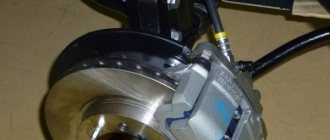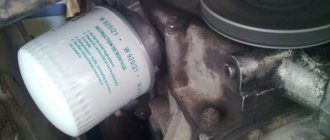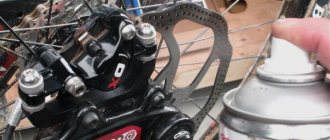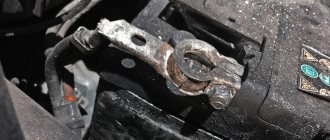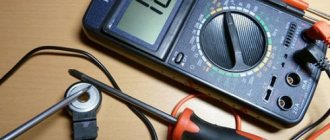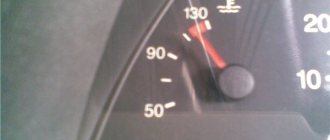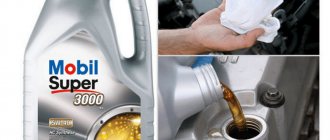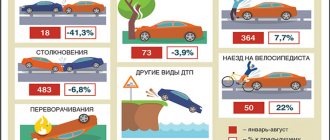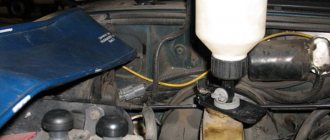Don't mix different classes
It would seem that the liquid has gone a little, and to fix the problem, you just need to add it to the required level. However, not all so simple. Different cars use different classes of brake fluid. The most common are DOT-3 and DOT-4. They all differ in properties and, importantly, boiling point. If you add the wrong grade of brake fluid to the reservoir, it will have a detrimental effect on the operation of the entire system. Also, this mixture will corrode sealing cuffs and other elements. Therefore, it is important to clarify what brake fluid was previously used in the car. On domestic brands GAZ and VAZ, RosDOT of the fourth class is used from the factory.
Attention: brake fluid
It is most often to blame for the failure of the corresponding pedal.
Low level
of brake fluid filling in the expansion tank. There is a mark on it indicating the minimum volume required for normal brake operation. If the fluid drops below the line, air enters the system, the pedal stops feeling resistance, and the car stops braking.
It is advisable that the brake fluid does not drop to a minimum, since as the pads wear, the pistons push them deeper and deeper, therefore, more fluid is consumed. That is, at any moment it can fall below the required level. You need to check the amount of liquid regularly, even if the corresponding light bulb does not give a signal.
The next type of trouble that brake fluid can cause is the result of the negligence of the car owner himself. Filling brake fluid of the wrong class (for example, DOT3 instead of DOT 4) or mixing fluids from different manufacturers leads to corrosion of the seals and seals, clogging the entire brake line or a section thereof.
Boiling of the brake fluid leads to the fact that, if it corresponds to the class and the normal level in the reservoir, the pedal stops being caught right on the move. Everyone knows that overheating your brakes is unsafe. If it is not possible to avoid aggressive driving, especially in the summer heat, it is worth replacing the brake fluid with high-temperature fluid, and the brake discs with cooled and ventilated ones.
When checking the level and condition of the brake fluid in the event of a pedal failure, all hoses, cuffs, gaskets and seals are inspected in parallel: loss of tightness by the system is the second most likely reason for air from the atmosphere entering it.
Article on the topic
- “Where to fill and how to replace brake fluid.”
Air
This is another problem that causes interruptions in the operation of mechanisms. Airing the brake system is dangerous because the fluid may boil. As a result, it will be completely impossible to reduce the speed of the car, except perhaps with the handbrake. What is the reason? Air can enter the system if the tightness of the lines is broken. Typically, metal pipes (copper or aluminum) are used in the braking system. However, on the front calipers they need to provide mobility. In view of this, rubber tubes are also used in the design. They have a double layer. If the tube is frayed, you have time to notice the problem. However, if you ignore the problem, the base layer will also begin to fray. As a result, the liquid will flow out, and air will be sucked in from the atmosphere instead. Always pay attention to puddles under the car after parking. Perhaps at this moment one of the tubes was damaged. If the brake pedal fails when the engine is running due to air in the system, how to solve the problem?
Why does the brake pedal fail?
One of the elements of the described hydraulic system is a special composition circulating through tubes and other cavities. The main feature of brake fluid is that it cannot be compressed. As a result, the force from pressing the pedal is transferred “unchanged” to the pads, which stop the rotation of the wheel. “Sinking” indicates that the line has become larger in volume or has depressurized. The main causes of the problem are discussed below.
Low quality brake fluid
The composition circulating in the system is quite aggressive. Gradually, bad brake fluid begins to corrode rubber and even metal parts, hoses, and tubes through which it moves. The walls of the latter become thinner to such an extent that they swell when pressure is created. Because of this:
- an excess volume is created into which the brake fluid goes;
- when you add it, the pressure is restored, but the tubes may not be able to withstand it: microcracks form through which the liquid gradually leaves and air enters instead (when the pedal moves in the opposite direction, it is literally sucked in). In the worst situation, the hoses may burst.
Air in the brake system
Its entry into the line is a consequence of depressurization of components and parts of the brake system. A plug may also form due to the fact that the fluid level in the tank has dropped below the existing MIN mark. Another reason is improper bleeding of the brakes when replacing the circulating compound. The danger with air in the system is that, unlike liquid, it is compressed. As a result, the force applied to the pedal goes to waste - in the literal sense of the word.
Master cylinder malfunction
Its main problem is most often related to depressurization. This occurs due to deformation and rupture of seals - cuffs. Their destruction is caused by poor-quality brake fluid or natural aging of the elements. The main brake cylinder becomes leaky even if scratches or wear appear on its walls. This occurs due to the appearance of foreign particles in the line. They can get inside if the system is carelessly and inaccurately filled. Sometimes “extra” elements are wear and tear products if the car has been in use for a long time.
Article on the topic: Purpose of oil and oil filter
Repairing a brake cylinder is a difficult task. If you do not have the relevant experience and do not have special tools or devices, it is better to take the part to a workshop or buy a new one.
Problems with the vacuum booster
If it is faulty, then most often this can be determined by the characteristic hissing sound that occurs when you press the brake pedal. This situation may indicate depressurization of the vacuum pump. The reason may lie in a ruptured diaphragm, seals, or a broken equalizing valve. To solve the problem, purchase a repair kit and replace all rubber parts. Air can also enter the vacuum booster due to cracks in the underwater pipes: tighten the clamps on them or, if damaged, replace them (in a carburetor car, such a hose fits at the bottom of it).
Incorrect clearances
We are talking about the presence of a gap between the main brake cylinder (its rod) and the pedal. The latter in this case fails and remains in this position. If the clearance is correct, the pedal will initially move smoothly, but at a certain period of travel it will become stiff. If the distance to the GTZ rod is large, resistance to pressing will be felt only at the very end of the stroke.
Unprofessional repair
The reason when the brake pedal fails may lie in the caliper, the fastenings of which are not tightened well enough. Then its vertical axis will be shifted in relation to the brake disc and the pads will not be able to get used to function properly. Also, any unprofessional actions (poor tightening, lack of spring washers where needed, etc.) when repairing or bleeding the brake system will lead to its ineffective operation.
Corrosion
The metal that makes up some of the brake system elements can simply rust. In such cases, the pedal goes down and freezes there, from where it has to be “picked out” with a pry bar or other improvised tool. Corrosion usually succumbs to traction, which just needs to be sanded off.
Brake pad wear
In this situation, an increased gap appears between the disc and the pads. As a result, the pressure created in the system is not enough to brake the wheel. The solution is obvious: replacing the pads.
Tools for leveling
Let's consider the pumping process using the example of Volga-made cars. So, for this we need:
- Transparent silicone tube (its diameter should be identical to the fitting on the caliper or drum).
- Keys for 8 and 10.
- Ballonnik.
- Jack, anti-rollbacks.
- Container for draining old fluid. An empty mineral water bottle will do.
By the way, recently special wrenches for unscrewing brake fittings have begun to appear in stores. How are they useful? Unlike horn-type tools, they use more edges. But the fitting tends to turn sour (it is located in a very dirty place). Therefore, there is a risk of “licking” the edges of the bolt.
Brake system Chevrolet Lacetti
__________________________________________________________________________________________________
The Chevrolet Lacetti service brake system is hydraulic, dual-circuit, with diagonally separated circuits. In normal mode, when the system is working properly, both circuits operate.
If one of the circuits fails (depressurizes), the other circuit provides braking to the vehicle, although with less efficiency.
Fig.51. Brake system components 1 - main brake cylinder; 2 — hydraulic drive reservoir; 3 — brake fluid level sensor; 4 - vacuum booster; 5 — pedal unit bracket; 6 — brake signal switch; 7— brake pedal; 8 - splitter, 9 - ABS unit The working brake system includes wheel brake mechanisms, pedal assembly, vacuum booster, master cylinder, hydraulic reservoir, anti-lock braking system unit, as well as connecting tubes and hoses. The brake pedal is a suspended type. A brake signal switch is installed in the pedal assembly bracket - its contacts close when the brake pedal is pressed.
Fig.52. Pedal assembly with vacuum booster and main brake cylinder 1 - main brake cylinder; 2 — hydraulic drive reservoir; 3 — brake fluid level sensor; 4 - vacuum booster; 5 — pedal unit bracket; 6 — brake signal switch; 7—brake pedal The vacuum brake booster is located between the brake pedal and the main brake cylinder and is secured with four nuts to the pedal assembly bracket. The vacuum amplifier is non-separable; if it fails, it is replaced with a new one.
Fig.53. Main brake cylinder 1 - hydraulic reservoir; 2 — tank cover; 3 — brake fluid level sensor; 4 — sensor connector; 5 - main brake cylinder The main brake cylinder of the Chevrolet Lacetti is attached to the vacuum booster housing with two nuts. On top of the cylinder there is a common hydraulic reservoir for the brake system and clutch, which contains a supply of fluid. On the body of the tank there are marks for the maximum and minimum liquid levels. There is a liquid level sensor installed in the tank, which, when the liquid level drops below the MIN mark, turns on a warning light in the instrument cluster. When you press the brake pedal, the pistons of the brake master cylinder move, creating pressure in the hydraulic drive, which is supplied through tubes and hoses to the working cylinders of the wheel brake mechanisms.
Fig.54. Front wheel brake mechanism 1 - brake pads; 2 — brake disc; 3 — bolt securing the caliper to the guide pin; 4 — caliper; 5 - copper sealing washers; 6 — brake hose mounting bolt; 7 — pad guide; 8 — spring brackets; 9 — guide pin cover; 10 - guide pin The brake mechanism of the front wheel is disc, with a floating caliper, which includes a single-piston wheel cylinder. For more efficient cooling, the brake disc is ventilated. The brake pad guide is attached to the steering knuckle, and the caliper is attached with two bolts to guide pins installed in the pad guide holes. Protective rubber covers are installed on the fingers. Grease is placed in the holes for the pins of the pad guide. When braking, the fluid pressure in the hydraulic drive of the brake mechanism increases and the piston, moving out of the wheel cylinder, made integral with the caliper, presses the inner brake pad to the brake disc. Then the caliper (by moving the guide pins in the pad guide holes) moves relative to the disc, pressing the outer brake pad against it. The cylinder body contains a piston with a rubber sealing ring. Due to the elasticity of this ring, a constant optimal clearance is maintained between the brake disc and the brake pads.
Fig.55. Parts of the rear wheel brake mechanism 1 - shoe guide; 2 — spring bracket; 3 — brake pads; 4 — caliper; 5 — bolt securing the caliper to the guide pin; 6 - copper sealing washer; 7 — brake hose mounting bolt; 8 — guide finger; 9 — guide pin cover The brake mechanism of the rear wheel of the Chevrolet Lacetti is a disk one, with a floating caliper, which includes a single-piston working cylinder.
The design and principle of operation of the rear wheel brake mechanism is similar to the front wheel brake mechanism. The shoe guide is attached to the rear suspension knuckle. The brake disc, unlike the front wheel brake disc, is not ventilated. The parking brake mechanism is located in the central part of the brake disc. The parking brake mechanism is drum, with two brake shoes. In design, it resembles a conventional drum brake mechanism.
Fig.56. Parking brake mechanism 1 - front block; 2 — spring cup; 3 — tension spring of the front block; 4 — spacer bar; 5 - rear block tension spring; 6 — pressure spring of the spacer bar; 7 — rear block; 8 — parking brake drive lever; 9 — parking brake cable; 10 — lower tension spring; 11 - clearance adjuster; 12 — brake mechanism shield The brake drum for it is the inner side of the central part of the brake disc. All parts of the parking brake mechanism are fixed to the brake mechanism shield. On the rear block there is a parking brake drive lever, to which the parking brake cable is hooked.
Fig.57. Components of the Chevrolet Lacetti parking brake mechanism 1 - brake disc; 2 — support stand; 3 — pad pressure spring; 4 — front block; 5 — tension spring of the front block; 6 — spacer bar; 7 — fixing plate; 8 — tension spring of the rear block; 9 — pressure spring of the spacer bar; 10 — rear block; 11 — brake mechanism shield; 12 — spring cup; 13 — lower tension spring; 14 — threaded tip of the regulator; 15 — regulator nut; 16 — tip of the adjuster The upper ends of the brake pads are pressed by tension springs to the spacer bar, and the lower ends are pressed to the gap adjuster between the pads and the inner surface of the disc. The regulator is a spacer bar consisting of two tips and a nut. One threaded tip. When the nut rotates, the length of the regulator changes due to the threaded tip, as a result of which the regulator moves the pads apart or closer. The drive of the parking brake system is manual, mechanical, cable, on the rear wheels. It consists of a lever with a rod and an adjusting nut, an equalizer, two cables and parking brake mechanisms in the rear wheel brake mechanisms.
Fig.58. Parking brake lever 1 - rod with cable equalizer; 2 — nut retainer; 3 — rod finger; 4 — adjusting nut; 5— parking brake lever; 6 - switch for indicator of parking brake activation and brake system malfunction. The parking brake lever, fixed between the front seats on the floor tunnel, is connected to two cables through a rod and an equalizer. The rear cable ends are connected to the parking brake drive levers mounted on the rear shoes. The parking brake is adjusted by rotating the adjusting nut located on the rod with the cable equalizer. All vehicles are equipped with an anti-lock brake system (ABS). Brake fluid from the master cylinder enters the ABS unit, and from it to the brake mechanisms of all wheels. The ABS unit, mounted in the engine compartment on the left side member, near the bulkhead, consists of a hydraulic unit, a modulator, a pump and a control unit.
Fig.59. Anti-lock braking system (ABS) 1 - control unit; 2 — hole for connecting the brake master cylinder tube; 3 — hole for connecting the brake tube of the left front wheel; 4 — hole for connecting the brake tube of the right front wheel; 5 — hole for connecting the brake tube of the left rear wheel; 6 - pump; 7 — hole for connecting the brake tube of the right rear wheel; 8 — hydraulic block; ABS Chevrolet Lacetti operates depending on the signals from the wheel speed sensors. Sensors are inductive type. The front wheel speed sensor is installed in the steering knuckle hole and secured with a screw. The sensor master disk is pressed onto the housing of the outer drive joint. The rear wheel speed sensor is built into the rear wheel hub. If the rear wheel speed sensor fails, it is necessary to replace the hub together with the sensor. When braking, the ABS control unit detects the beginning of wheel locking and opens the corresponding modulator valve to relieve the pressure of the working fluid in the channel. The valve opens and closes several times per second, so you can verify that the anti-lock brake system is working by listening to the slight vibration of the brake pedal when braking. ABS has a built-in brake force distribution (EBD) system, which functions as a pressure regulator in the hydraulic drive of the rear wheel brakes. If the rear wheels begin to lock when braking the vehicle, the rear wheel brake inlet valves in the modulator switch to a constant pressure mode, preventing a further increase in pressure in the rear brake working cylinders. If the ABS malfunctions, the brake system remains operational, but the wheels may lock. In this case, a fault code is recorded in the unit’s memory, which is read using special equipment at the service center. A traction control system is integrated with the locking system, using signals from wheel speed sensors. The anti-lock braking system is controlled by a control unit.
__________________________________________________________________________________________________
__________________________________________________________________________________________________
__________________________________________________________________________________________________
______________________________________________________________________________________________
Operation and repair
- Chevrolet Cruze
- Chevrolet Aveo
- Chevrolet Niva
- Chevrolet Lanos
- Chevrolet Captiva
Lacetti
- Engine F14D4/F14D3
- Timing belt
- Engine repair
- Engine control system
- Engine sensors
- Fuel system
- Cooling system
- Clutch adjustments
- Gear box
- Gearbox maintenance and repair
- Automatic transmission service
- Front wheel drives
- Front suspension
- Rear suspension
- Steering
- Steering mechanism repair
- Brake system
- Brake service
- Electrical equipment
- Body parts
Let's get started
Pumping is carried out in a certain sequence. The diagram is criss-cross. First, the air is pumped out of the rear right wheel. Then - from the front left. Next they move to the rear left and then to the front right disc. So, we tear off the bolts from the desired wheel, put the car on a jack and install the stops. It is impossible to lift on clamped blocks. Next, open the hood and add fluid to the maximum. We will need an assistant who will press the pedal several times on command.
They said thank you:
I noticed these symptoms in myself. It hisses when the engine is running, but as soon as you press the brake pedal, the hissing immediately disappears. What could this be?
The fluid is normal at maximum, after 2500 km it went nowhere. I pumped it with the engine off and on
I brought the car from Germany, it was at the same level. at the minimum I decided to pump and top up, now this is the situation
Well, it’s very similar that for the first time I pumped it on a non-started one and blew up the ABC unit. On a non-started pump, I ran into this crap on the pedal-wool a couple of times on a René and on a Zorromobile. Swing on a wound-up everything to your liking, you weren’t the first to have a theme, man howled in a panic, I pumped and everything was lost, no hello, no answer. Well, of course, it’s possible that when pumping, I let the VUT know that it had run out, the last time we pumped it on an Impreza, so the pipe in the line broke and even went to the salon, but there the pipe was dead, it had corroded .
A properly functioning braking system is one of the main factors affecting traffic safety. Even the smallest deviations in its work should not be ignored; they must be eliminated immediately. A broken brake pedal is the most serious problem that can happen.
Diagnostics
It is important to diagnose this problem in a timely manner. Diagnostics should be carried out when there are obvious problems with braking. But here you need to understand that similar symptoms can be observed with problems with ABC, so you need to make a diagnosis. It can be produced in several stages:
- We press the brake pedal and start the engine, if it fails, then everything is in order. If nothing has changed, then the problem is the tightness of the amplifier or hoses;
- If the pedal goes down, then hold it for about a minute. If during this time it has gone even further, then there may be a problem in the master brake cylinder;
- Next, let the engine idle. If you press the brake pedal sharply, then the problem is again in the vacuum booster.
Having carried out the diagnostics, you can proceed to checking the problem unit; as a rule, it is easier to fix the breakdown by replacing the part.
1 Brake system - how it works and works
To understand why the brake pedal fails, you need to understand the structure and operation of brakes. Modern passenger cars use hydraulic brakes, the malfunctions of which are practically the same on different models. The force from pressing the pedal is transmitted through the brake fluid to the wheels and stops rotation. The liquid works in a closed system, acting on its elements. The hydraulic brake system is controlled by a pedal, forcing fluid to act on the following components:
- the master brake cylinder, from which the force is directed to the wheels;
- working cylinders - force the brake mechanics to work and brake the wheels;
- mechanical - from pads acting on discs or drums;
- pipelines through which brake fluid moves.
Modern cars are equipped with a vacuum booster, which increases the pressure, increasing the effectiveness of the brakes.
After the driver presses the brake pedal, the force is transmitted to the piston of the master cylinder (MBC). It compresses the fluid, which transmits force through the lines to the wheel cylinders installed in each wheel. They act on the brake pads, which are pressed against the discs or drums. At maximum force, wheel rotation is completely blocked. The brake system can be disc, drum or combined. The combined brake system is equipped with discs at the front, providing greater braking efficiency, and drums at the rear.
When not to panic
- If you got behind the wheel, decided to start the engine after a long period of inactivity, pressed the brake and started the engine, and at that moment the pedal “went away,” then there is no need to look for a malfunction: the phenomenon is normal. The fact is that when the car starts, the hydraulic vacuum booster begins to work: the process involves installing the mechanisms of the unit into the working position. It’s just that there is a difference between the force transmitted to the pedal when the engine is turned off and when the engine is running.
- If the brake fails after completing repair work to replace the pads, it also does not always indicate problems. In this case, the pedal begins to “go away” after bleeding the system, but then functions normally. This is due to the pistons of the working brake cylinders - they “search” for some time for the optimal gap between the disc and the pads.
Article on the topic: Rule for everyone
2 The pedal fails - determining the reasons
Pedal drop is caused by the following factors:
- The fuel fluid level in the tank has dropped to an unacceptably low level. A vacuum is created, as a result of which the system becomes airy.
- Severe wear on pads and working surfaces. The piston stroke of the brake cylinders increases, the pedal has to be pressed all the way to the floor, but the required effect does not occur.
- The brake fluid is incorrectly selected or different types are mixed. Unsuitable fluid forms clots that interfere with normal brake operation and destroys rubber parts.
- The liquid boils, the pedal suddenly and strongly sinks. One of the reasons is an aggressive driving style in extreme heat.
- Breakthroughs, breakdowns, leaks in the system. Liquid flows out through them and air is sucked in.
We begin the check by inspecting the expansion tank. Even if you are sure that the fluid does not leave, the level drops over time due to wear of the pads, discs, and drums. The piston stroke becomes longer, the liquid leaves the tank into the system. We check the level using the marks on the expansion tank, and if it is insufficient, top it up. You should not wait for the light on the instrument panel to signal this; you should check visually from time to time. If the liquid from the tank leaks completely, air will enter and pumping will be required.
Only add fluid of the same type, preferably from the same manufacturer.
A situation where the pedal suddenly fails, but the level is normal indicates that the brake fluid has overheated and boiled. Regardless of the circuit used, the entire fuel fluid boils. At the same time, air bubbles are intensively released, disrupting the operation of the brakes. In addition to aggressive driving in hot weather, the cause may be constant braking when driving on sloping terrain. Such situations should be avoided if the braking system is not adapted to them. If necessary, we modify the brake system by installing ventilated brake discs and using a special brake fluid.
Each maintenance - not daily - requires checking the wear of brake pads, discs, and drums. Driving with heavy wear increases heat, parts wear out faster. The problem with drums and discs can be eliminated by replacing or regrooving. The work should be carried out for a pair on the axle. When the pads wear out, they are replaced with new ones.
content .. 141 142 143 144 ..Daewoo Nexia 2008. Increased brake pedal travel (brake pedal falls through)
Reasons for increased brake pedal travel
| Inspect all lines, their threaded connections and cylinders, and eliminate leaks. Restore the normal fluid level in the brake reservoir and bleed the system. If you find damage to the brake hoses (cracks, swelling or traces of brake fluid), replace the hoses. If you suspect defects in the master brake cylinder, replace it with a good one. | |
| The rubber cuffs of the cylinders are swollen due to oil, gasoline, etc. getting into the brake fluid. | Replace cylinders, hoses, completely drain the brake fluid, flush the system with fresh fluid and bleed |
| Overheating of brake mechanisms | Allow the brakes to cool. Use only DOT-4 brake fluids in the system. Replace brake fluid promptly |
| The gap between the pads and the drum has been increased (the automatic gap adjustment device does not work) | Replace the wheel cylinder, bleed the system |
| One of the circuits of the service brake system does not work | Eliminate fluid leakage from the brake system, bleed the system |
| Leak in the brake master cylinder | Fix the leak |
| Loss of elasticity of the internal rubber bands of the brake master cylinder | If you suspect defects in the master brake cylinder, replace it with a good one. |
| Increased (more than 0.15 mm) runout of the brake disc | Replace both drives |
The brake pedal falls off after starting the engine
There may be several reasons for such a malfunction. Quite often, diagnostics must begin with checking the brake fluid level in the reservoir. Any hydraulic system has the specified compensation tank. The tank has “min” and “max” marks, which determine the normal amount of fluid in the system.
The fact is that although the brake fluid is incompressible, the volume of fluid in the system changes. This occurs due to the fact that brake pads tend to wear out during use. As a result, the RTC pistons extend further to move the pads, which requires more fluid in the system. For this reason, the minimum level of working fluid in the tank is determined. When the amount of fuel fluid drops below the minimum, then air enters the brake system circuit, that is, airing occurs.
If the brake pedal fails, the causes of such a malfunction can often be a critical decrease in the fluid level or air ingress. When pressed, the brake pedal goes to the floor all the way, the brakes do not work completely or barely work. To prevent possible consequences, the level of brake fluid in the expansion tank must be checked visually, without waiting for the moment when the emergency lamp lights up on the instrument panel in the cabin.
If the ABS brake pedal suddenly fails or the pedal falls to the floor on cars without an anti-lock braking system, and checking the fluid level in the reservoir does not give anything (the level is normal), then overheating of the brakes may be the culprit. Brakes overheat in cases where there is intense and frequent braking at high speeds, constant and prolonged driving at low speed with the brake pedal pressed (for example, descents on mountain serpentines). More often, deterioration of the system in such modes occurs in conjunction with high outside ambient temperatures.
After replacing the brake pads, the brake pedal fails
New brake discs and brake pads should be worn in. While the grinding is not completed, the car may jerk after pressing the brake, the brake pedal begins to vibrate, and when braking, light vibrations can be transmitted to the steering wheel. Let us add that the general grinding in of new pads and discs takes from 250 to 400 km. mileage If the symptoms do not stop, then you should check the quality of the parts and the correct installation of the elements.
A common cause of brake problems, where the brake pedal slowly sinks, is a damaged or misaligned brake caliper that is present in the design of the brake system. The displacement of the vertical axis of the caliper relative to the axis of the brake disc does not allow the system to work normally. Also, the caliper may be in good working order, but poorly secured. In such cases, the brake pads are simply not able to properly rub into the disc.
When the engine is running, the brake pedal falls down
The most common reasons for the brake pedal to fail when the car is running are air in the system, problems with the turbocharger, low fuel fluid level, critical wear of the pads/discs, overheating of the brakes, etc.
When the brake pedal does not fall, but remains very stiff after starting and the effectiveness of the brakes is greatly reduced, then the brake booster should be checked. Additionally, its malfunction is indicated by the fact that the engine speed fluctuates when you press the brake, although the fluid does not leave the brake system reservoir, and also when the engine is turned off, the brake pedal always remains elastic, and not after several presses.
The brake pedal fails: the brake fluid does not drain
If there is a leak, the brake system inevitably becomes airy. It turns out that if the brake pedal sinks, but the fluid does not leave, this does not mean that the system is sealed. Two or three drops of fuel oil will not affect the level in the reservoir, the leak itself may be difficult to detect, but the brakes will not work properly.
Brake fluid may be leaking through the master cylinder, but the leak can only be detected by disconnecting the master cylinder from the brake booster. It often happens that the cylinder is not completely filled.
After changing the brake fluid, the brake pedal fails
First of all, this may mean that air remains in the system.
If the brake pedal fails after repair, then there is a high probability that errors were made during assembly, the system is not pumped well enough, there are brake fluid leaks, etc.
Brakes lost after heavy braking
The reason may be a break in the brake hoses, tubes, or breakdown of the brake cylinders (main or working). The brake pedal also drops sharply when there is severe wear on the discs or brake drums or brake pads. In this case, the piston of the working cylinder is pushed out.
Another reason may be overheating of the brake fluid during very active braking (brake overheating).
content .. 141 142 143 144 ..
3 Replaced the brake units - the pedal goes to the floor
Often, after replacing the turbocharger or components, the desired effect does not occur: the pedal failure remains or appears periodically. It should be understood that this may occur for a certain time, since the car is not operated as usual. The components grind in for a while, while the car jerks while moving and the pedal vibrates. A slight vibration is sometimes transmitted to the steering wheel. Grinding in can take 250–400 km. If signs of malfunction have not stopped, we find out the reasons: we check the parts for quality and correct installation.
Diagnostics – what does it include?
If the problem is not yet too obvious: something seems to be wrong, but the braking function is working, you can start with self-diagnosis. Very often, failure occurs due to the fact that insufficient pressure is applied to the pads and discs. This may be due to interruptions in the supply of brake fluid. Start the engine, press the pedals and listen - extraneous sounds are the most obvious sign.
The most important thing is not only to notice in time that the brake pedal has failed. The second important aspect is conducting competent diagnostics. I advise you to contact only proven service stations and not skimp on full diagnostics.
Remember how much time has passed since the brake began to noticeably go down, the last time the fluid was changed. Perhaps it is no longer enough - try adding more. If this does not help, you will have to find out at the service station why the brake pedal failed. Otherwise, such a brake may simply fail at one moment. A quality diagnostic will include a full check of the entire brake system. Particular attention should be paid to the master brake cylinder - if the problem is there, alas, replacement will be required. A good technician will also check the tightness of the pumps, the pressure in the system, the condition of the discs and pads. High-quality diagnostics will take at least 5-6 hours and will cost money: but whatever, the braking system in the car must be at its best.
4 Vacuum booster - symptoms of malfunction
Almost all cars have a vacuum booster. It reduces the force applied by the driver to the pedal, while at the same time increasing the force transmitted by the fluid. It only works after the engine is started. Poor performance is often caused by wear or damage to the vacuum seal diaphragm. In this case, no vacuum is created in the chamber. We need to look at the fuel fluid level: if it is normal, we check the operation of the amplifier. If the vacuum tank is not topped up in a timely manner, it first malfunctions, then the diaphragm is damaged.
First, we check with the engine not running: depress the pedal and hold it pressed. If it begins to gradually fail, the reason is in the gas turbine engine: the cuffs are leaking or the working surface of the cylinder is worn out. Without releasing the pedal, we start the engine. It should fall smoothly and slightly and stop. If everything is exactly like this, then the vacuum seal is in order. If the pedal falls while the engine is running, the reason is in the amplifier, the GTZ is to blame. When driving with a damaged diaphragm, the speed during braking practically does not decrease. You need to immediately replace the diaphragm with a new one.
When the vacuum seal dies, when braking, the car, especially in cold weather, tends to stall, and the noise of escaping air is clearly audible.
Solution
If your car has such a breakdown, the main thing is to solve it comprehensively. It happens that malfunctions are associated with several reasons at once. If the problem is that the pedal is simply rusty, it needs to be replaced. It is easy to correct the situation by replacing the brake fluid with a higher quality one. By the way, you will have to update the fluid in any case - in order to “update” the entire system. Otherwise, over time, the pedal will definitely begin to fail when pressed.
If cracks appear in the pumps, the brake may also begin to fail. Moreover, even microdamages can be the cause of such a breakdown. So if you want the brake to function and not fail in the middle of the road, you will have to replace everything that has stopped working. It turned out to be enough for me to make one replacement. At this point, the question of why the brake pedal failed was closed. To be convinced, it was enough to just start the engine. No extraneous sounds. And if before the return after pressing was too slow, now everything works perfectly.
